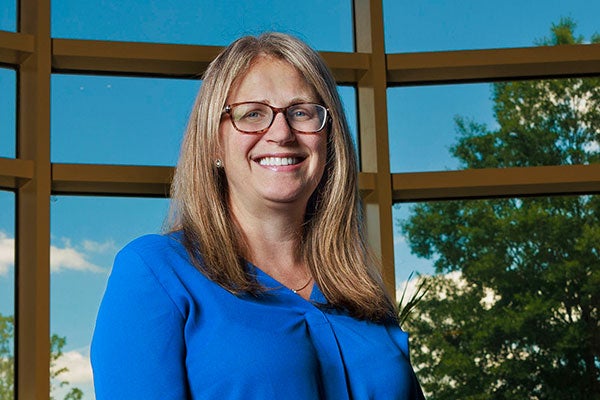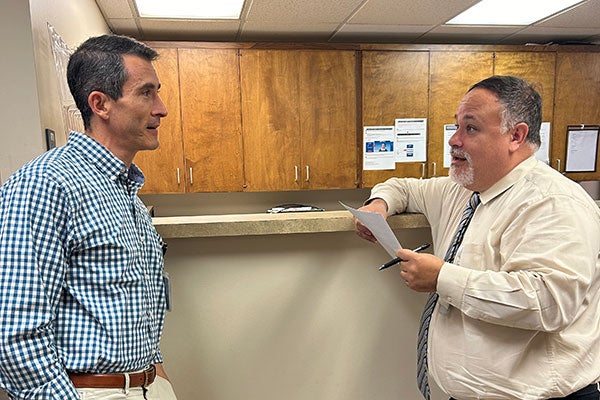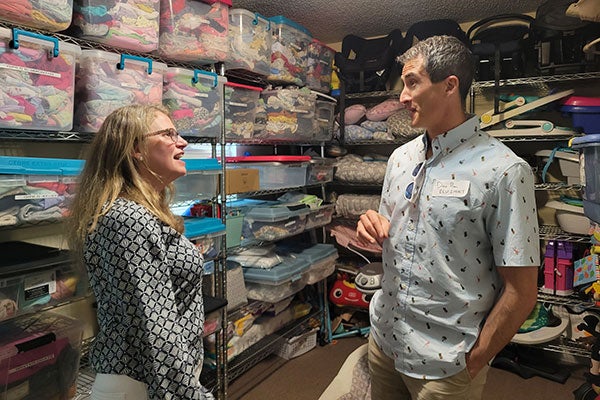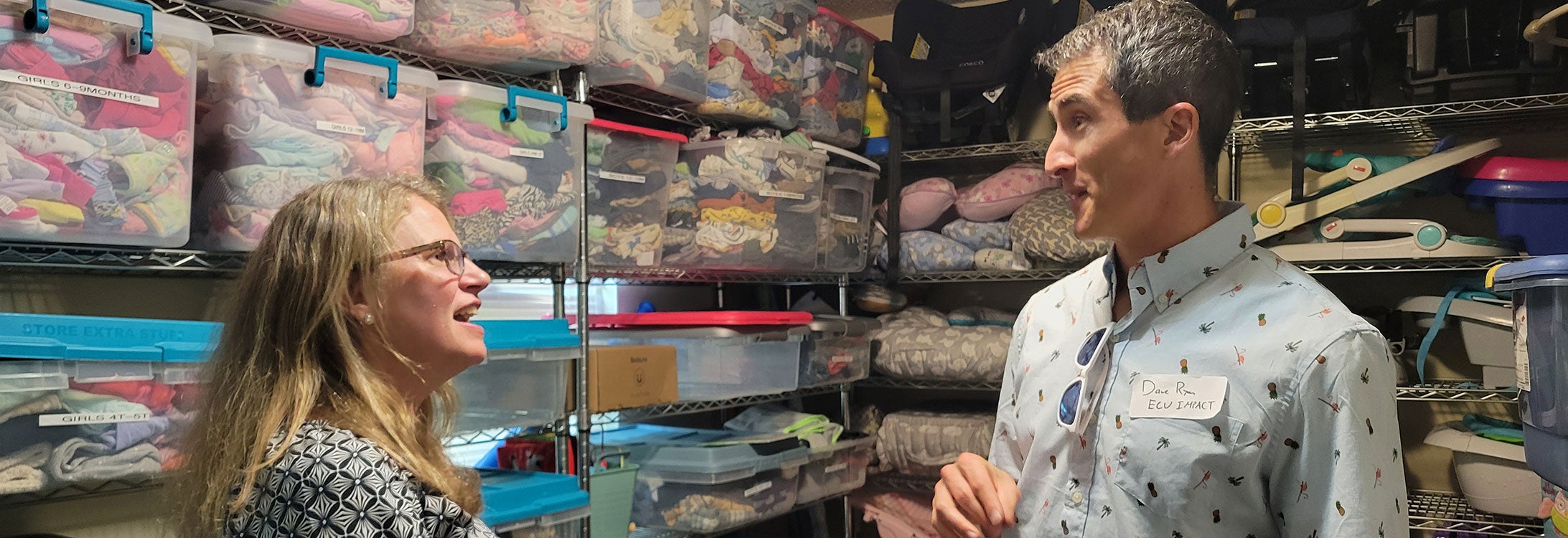Grants to address substance use disorder crisis in eastern NC
A team of researchers and clinicians from the East Carolina University’s health sciences schools and colleges has been awarded a nearly $900,000 grant from the federal Substance Abuse and Mental Health Services Administration (SAMHSA). The funds will be used to reduce health disparities and improve substance use disorder related outcomes in eastern North Carolina by improving access to treatment.

Dr. Chandra Speight is the principal investigator for the ECU-AMMPeD or Amplifying Medical, Midwifery, Nurse Practitioner, and Dental education student education and outreach program. (Photo by Steven Mantilla)
The new grant funding will be used to improve health care students’ training and provide education opportunities to providers working in the region. The program, titled ECU-AMMPeD or Amplifying Medical, Midwifery, Nurse Practitioner, and Dental education – is intended to improve substance use disorder (SUD) treatment access in eastern North Carolina. The team is led by the College of Nursing’s Dr. Chandra Speight, principal investigator, and Dr. Sarah Noe, project coordinator.
“Our region has some of the worst substance related outcomes in the nation, in part due to a lack of regional capacity to screen for and treat substance use disorders. This grant provides funds to improve the substance use disorder training our students receive and provide continuing education opportunities to regional providers,” said Speight, assistant professor in the Department of Advanced Nursing Practice and Education.
Speight and Noe are joined in the project by Drs. David Ryan, Angela Kallis and Brandon Kyle from the Brody School of Medicine; Drs. Brittany Baker, Renee Spain, and Adrian Lennon and Josh Peery from the College of Nursing; Dr. Leigh Atherton from the College of Allied Health Sciences; and Drs. Mark Moss and Taneet Ghuman from the School of Dental Medicine.
“Educating students to treat substance use disorder in a region that lacks sufficient provider capacity poses challenges. The grant provides funds for clinical placement and for building virtual clinical opportunities for ECU students. It also allows for interprofessional opportunities so dental, medical and nurse practitioner students can work together on issues related to substance use disorder treatment,” said Speight. “This partnership underscores our understanding that tackling the substance use disorder crisis requires a team approach.”

Dr. Mark Moss of the School of Dental Medicine lectures students in 2021. (Photo by Rhett Butler).
Pamlico County is an example of the incredible strain that substance use disorder is having on rural parts of the state: overdose deaths are 86.4 per 100,000, versus the national rate of 33.0 and a state rate of 36.9 per 100,000.
An additional grant from the Aetna/CVS Foundation, led by Dr. David Ryan of the Brody School of Medicine, will help ECU health educators to establish the state’s first network of perinatal substance use disorder clinics. Ryan and Speight are working with partners across the state to improve access to substance use disorder care for pregnant people as new mothers, as substance use disorder is a leading cause of maternal death.
The numbers relating to addiction and substance use disorder in North Carolina are stark: nearly half of the state’s children in foster care are there due to parental substance use, 41 of the state’s 100 counties are in the highest risk group for opioid-related harm based on high overdose death rates and low treatment capacity, and a March 2024 report found nearly 40% of maternal deaths were substance related and most involved unintentional overdose.
Opioid misuse has profound consequences for the health of individuals and families, particularly in the rural, eastern end of the state. A severe lack of providers with specific substance use disorder training coupled with a population that is difficult to reach because of the stigma of addiction creates and environment for the ECU-AMMPeD program to offer an invaluable lifeline to the region, Speight said.
Educating the Next Generation of Providers
Research shows that when doctors, nurses and dentists look and sound like the patients they care for, health outcomes improve. Taken as a whole, Pirate health care providers – many of whom stay in rural eastern North Carolina after graduation – are part of the solution.

Dr. David Ryan, an obstetrician and addiction medicine doctor, is part of the leadership team of the ECU-AMMPeD or Amplifying Medical, Midwifery, Nurse Practitioner, and Dental education student education and outreach program speaks with a colleague. (Contributed photo)
The constituents of ECU’s health sciences education and training base offer hope. The Brody School of Medicine ranks 13th in the nation for diversity and is in the top 10% for graduating Native American and Black physicians. The College of Nursing graduates more nurse practitioners than any other institution in the state and has the only nurse midwifery program in North Carolina, South Carolina or Virginia. Thirty percent of the School of Dental Medicine’s 184 currently enrolled students are from under-represented minority groups, 14% are from disadvantaged backgrounds and 60% identify as female.
The ECU-AMMPeD simulation training will leverage an already industry-leading simulation program lead by Josh Peery from the College of Nursing.
“We plan to create virtual case studies that allow students to practice working with a highly stigmatized population in a virtual environment,” Speight said.
Dr. Mark Moss, ECU associate professor of dental medicine and director of the division public health dentistry and Dr. Taneet Ghuman, director of interprofessional education at the dental school, welcomed the inclusion of dental students as part of the training cohort. Substance use disorder is increasingly recognized as an important part of the school’s curriculum. Continuing education is required by the Drug Enforcement Administration for anyone authorized to prescribe opioid medications, and Moss is thankful that the ECU-AMMPeD grant will further enrich the education that students receive using an interprofessional model of practice.
“As dentists many of us were trained in a very narrow environment, kind of siloed within the health care system where we learn how to take care of the mouth and acquire skills for effective pain management,” Moss said. “This project provides an opportunity to demonstrate how a team-based approach can be implemented to address substance abuse disorders within a wider context of patient care. This can make a difference in eastern North Carolina and statewide.”
Moss stressed that dentists’ offices might seem disconnected from one another, and from other health care providers – especially in rural areas – but that isn’t necessarily the case. The reality is that dentistry is part of the primary care system. Interdisciplinary education can help foster and strengthen relationships that are poised to help tackle the substance use disorder crisis in North Carolina.
“This training builds the understanding and skills for ways to ask questions and talk about sensitive topics with our patients, as well as knowledge concerning the resources for community engagement and connection with other health professionals who can help us manage these situations,” Moss said.
Serving rural communities
One of the ECU-AMMPeD co-Investigators is Dr. David Ryan, a Brody School of Medicine faculty member who is board certified in both obstetrics and addiction medicine, a relatively rare pairing that makes him an “interesting bird” who is motivated to help people understand the chronic medical nature of addiction.

• Drs. Chandra Speight and David Ryan visit the perinatal supply closet at the Tides Clinic in Wilmington, which provides supplies for mothers in early recovery and their children. Speight and Ryan were on a tour of partner organizations for their grant-funded program. (Contributed photo)
Ryan signed on early to be part of the ECU-AMMPeD program, which pairs well with the Aetna/CVS Foundation grant that will link five regional North Carolina institutions to create the state’s first perinatal substance use disorder network. Doctors, dentists, nurses and other health care providers who make up the network work to find innovative solutions to the frighteningly high rate of overdose deaths in mothers in the year following giving birth, and share those best practices among the network members and beyond.
Hormonal fluctuations and lack of sleep, coupled with financial and familial pressures, are challenging for any new mother, Ryan said, but substance use disorder often makes receiving care even harder.
“Mothers go through a pretty traumatic and dramatic experience with childbirth. It’s pretty standard in American health care that after two days we send them home and say, ‘See you in six weeks,’” Ryan said. “Then we talk to them for 15 minutes and say, ‘We’ll see you in a year.”
As an addiction specialist, Ryan said the statistics for new mothers are jarring. A study of 2019 data showed a quarter of all perinatal deaths resulted from overdose, which was the top cause of mortality in that cohort.
“Not hemorrhage or infection or cardiomyopathy. The study also included homicides and suicide which is 6.5 %, which is also shocking,” Ryan said, though he sees glimmers of hope that come from the grants’ investment in vulnerable populations.
Addiction doesn’t just impact the person using, but also that person’s family, for older as well as younger generations. Ryan believes working with his patients is an investment in the future, to empower them to be part of that generational change.
“It’s a really big problem, but one that we feel very strongly can be positively affected by what we’re doing here with the SAMHSA grant, the Aetna grant and also with the perinatal program,” Ryan said.
By training students from a variety of medical disciplines to recognize and treat substance use disorder, especially in new mothers, Ryan believes they can reduce the source of addiction in coming generations.
“Our students are hungry, they want to know how they can be part of the solution,” Ryan said. “I can see, maybe one patient every 30 minutes — multiply that by 8 hours a day, five days a week, and now I’m done. But if I can educate 100 students and maybe half of them go on to understand addiction, now we’re influencing thousands upon thousands of people.”
